
In Dr Henry Schneiderman's interesting case of swelling and redness of the lids in an elderly woman, the photograph clearly illustrates a sharp demarcation of the area of swelling above the cheekbone.

In Dr Henry Schneiderman's interesting case of swelling and redness of the lids in an elderly woman, the photograph clearly illustrates a sharp demarcation of the area of swelling above the cheekbone.

Is this acneform eruption on a middle-aged woman’s face perioraldermatitis? Rosacea? Pyoderma faciale? Is this pruritic rash related to ayoung woman’s tanning salon visits? Scrutinize the photos, make yourdecisions, and compare your answers with an expert’s.

Rickettsia rickettsii is transmitted tohumans by a tick bite. This boy hadbeen camping a short time beforea fever and the classic rash of RockyMountain spotted fever developed.The erythematous macular rashfirst appears on wrists and anklesand spreads to the trunk. Note thepuffy appearance of the skin resultingfrom vasculitis.
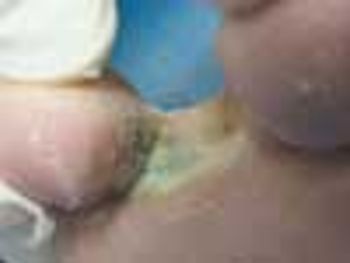
For a year, a 31-year-old man had asymptomatic, malodorous discoloration of the toe web spaces. He stated that his feet perspire heavily in the boots he is required to wear for work.

Painful cysts on the sternal and left axillary regions that had worsened over the past 3 weeks prompted a 42-year-old man to seek medical care. He reported that similar lesions in the same distribution first arose when he was 25 years old, and they recur each year. He denied having cystic acne in adolescence.

Appropriate foot care, preventive measures, and early intervention reduce the incidence of complications and lower extremity amputation in patients with diabetic foot ulcers. A thorough lower extremity examination includes assessment of the skin, interdigital areas, skin quality and integrity, and ulcerative or pre-ulcerative changes. The key to prevention is patient education and lifelong commitment to self-care.

This 9-year-old girl had a slightlypruritic perioral rash for 6 months.The skin around her mouth wasred, scaly, thickened, and hyperpigmented.She also had eczematouslesions in the antecubital andpopliteal fossae.
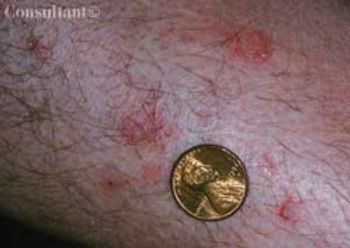
The multiple, uniformly scaly, coin-shaped, papulosquamous lesions shown here on the lower leg of a 61-year-old man had persisted for 3 months despite application of topical clotrimazole and 1% hydrocortisone. The rash involved only the legs and was variably pruritic. The patient had a long history of dry skin.

For 3 days, a 5-month-old infant had a red, papular, nonpruritic rash around her mouth and vesicles on her hands. The child was being breast-fed by her mother, who had a similar rash around her nipple. The child was afebrile, and the physical examination revealed no abnormal findings. There was no history of allergy or change in diet.
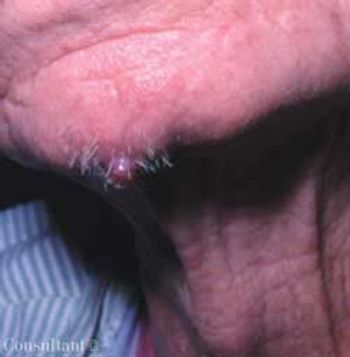
he sudden appearance of an asymptomatic, 6 x 4.5-mm, exophytic, red nodule on the chin prompted an ostensibly healthy 73-year-old nonsmoker to seek medical attention. His nodes were not enlarged, and he had no other skin lesions.

ABSTRACT: Rely on the history and physical findings when you evaluate a hand injury. After you control any active bleeding, test the motor and sensory functions of the radial, ulnar, and medial nerves. Use the rule of the 5 P's-pulses, pallor, pain, paresthesia, and paralysis-to guide the vascular examination. Assess the muscles and tendons by testing their flexion and extension functions against mild resistance. After anesthetizing any wound sites, apply high-pressure saline irrigation to remove debris and reduce bacterial contamination to prevent infection. To repair skin injuries, use a closure method appropriate to the condition of the wound. Infection-prone wounds-such as crush, grossly contaminated, and bite injuries-may require antibiotic prophylaxis and possibly delayed closure.

For several months, a 59-year-oldwoman has had numerous asymptomaticlesions on her arms andlegs. During this period, she has notbeen exposed to the sun and hastaken no new medications.

When patients complain of malodoroushidrosis of the feet and they havetried every over-the-counter remedy,suggest they apply a regular underarmdeodorant/antiperspirant to theirfeet after showering

A 67-year-old woman with insulin-dependent diabetesmellitus and uncontrolled hyperglycemia complained offatigue and malaise. For 2 years, a draining ulcer hadbeen present on the bottom of her left foot.
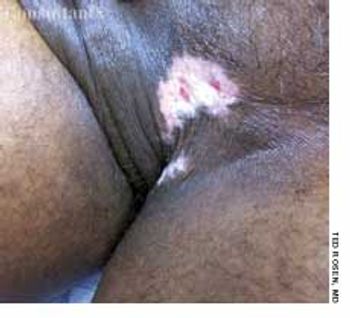
A 46-year-old man complained of “irritation” in the groin of several months’ duration. Ted Rosen, MD, of Houston noted a tender, macerated, hypopigmented plaque at the junction of the scrotum and upper inner thigh. At the periphery of the lesion was some detectable erythema and within the plaque were several small, superficial erosions.

A 20-year-old woman presents with a 3-week history of a pruritic, progressivelyenlarging erythematous lesion on one arm. She has a cat and recentlystarted horseback riding lessons. She is otherwise healthy and takes nomedication.

For a few days, this 73-year-old woman had had an itchy, painful rash on the right side of her face. Despite its proximity to her eye, she had no ocular involvement and no blurring of vision.

Two weeks earlier, this 66-year-old man had been hospitalized because of leftsided chest pain. However, cardiac evaluation revealed no abnormalities.
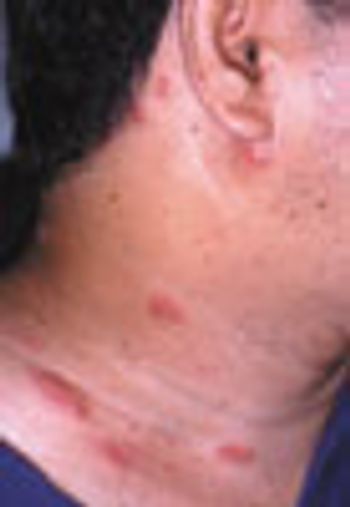
For 3 days, a 44-year-old man had several crops of tiny vesicles with raised erythematous bases on the right side of his neck and 2 elongated maculopapular lesions at the base of the neck. All of the lesions were within the C3 dermatome.
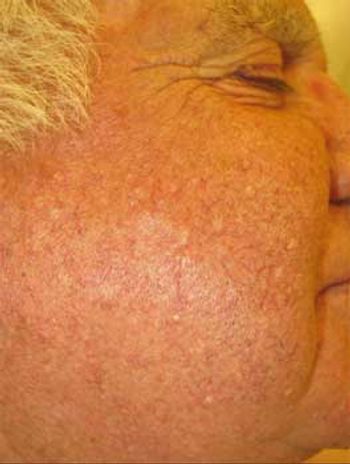
For 3 years, numerous skin-colored papules had been present on the face of a 59-year-old man. The lesions developed several months after renal transplantation and the start of immunosuppressive therapy.

35-year-old Hispanic man presented with nonproductive cough; dyspnea; fever; and a painful, ulcerated, 1.5-cm, red-brown plaque on the left flank. He had had the lesion for 3 months and the symptoms for 1 week. The patient had grown up in Arizona, and he traveled there 4 months before the lesion arose.
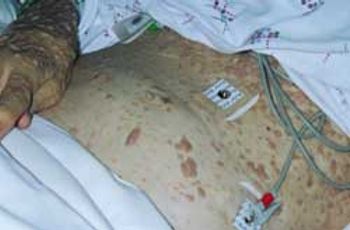
Since adolescence, a 67-year old woman had had multiple nodular lesions on her body that were painful at times, particularly when pressure was applied. She reported that other family members, including her mother and brother, had similar lesions.

A54-year-old white woman presentswith extremely tender,firm lesions on the right hip and legsthat have been increasing in size andnumber over the past few months.

A 6-year-old girl (A) and an 11-year-old boy (B) each presentedfor evaluation of an erythematous, pruritic, papularrash that developed after swimming in a Wisconsin lake.Each child was otherwise completely healthy.

This 10-year-old boy presented forevaluation of a rash that developedduring a spring vacation on Florida’sAtlantic coast. After he had beenswimming in the ocean, a pruritic,erythematous, papular rash developedon his trunk, axillae, and groin. Approximately24 hours after the onsetof the rash, he experienced malaise,chills, and a sore throat. His past medicalhistory was unremarkable. Hehad been fully immunized and hadhad varicella infection.